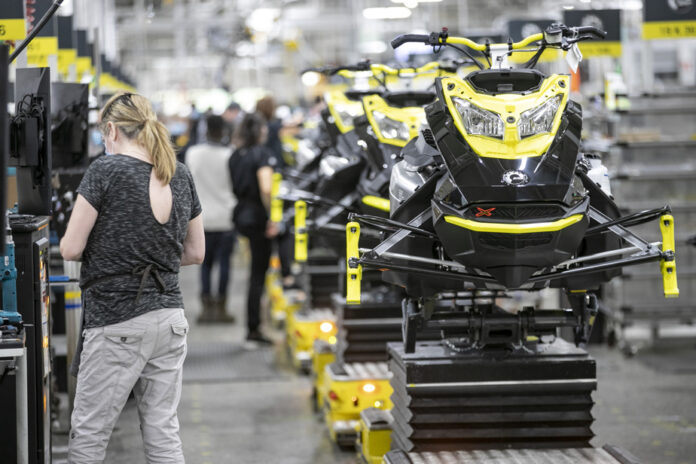In a few weeks, BRP’s first electric snowmobile will leave the factory. It will be one of the fruits of the $300 million investment plan launched by the Valcourt firm to expand into new electrified mobility markets, particularly in cities.
By 2027, BRP intends to have developed an entire portfolio of electrical leisure products. The company has already announced the launch of a range of Can-Am motorcycles, a Sea Doo hydrofoil board, and the powertrain for Rotax E10 karts. “By 2035, we are aiming for 50% of our units sold worldwide to be electric,” says Sandy Scullion, president of the Powersports Group at BRP.
The multiplication of these electric models is based on a strategy of internal development of the technologies necessary for electrification. “This allows us to not be limited by existing components, and to be able to accelerate development when necessary,” explains Mr. Scullion.
The implementation of this strategy led to the acquisition of companies occupying key positions in the design and manufacturing of electric bicycle components, including Kongsberg Activities in Shawinigan, specialized in the manufacturing of electronic and mechatronic products, but also recently in Germany with an 80% stake in Pinion, which specializes in gearboxes.
It is on this technological mastery that BRP relies to allow Mr. Scullion to declare: “We are clearly entering the urban mobility market. » All the elements of the puzzle are ready to see the arrival on this market of an electric bicycle designed and manufactured by BRP, which is now eyeing the immense global market of urban mobility.
This is the value of the global urban mobility market, towards which BRP has decided to move. This is twice the value of the powersports market.
The launch date of BRP’s future electric bike is not yet known. But “it will be in the relatively near future,” assures Sandy Scullion.
Given BRP’s interest in electric mobility, can we expect to see an electric automobile arrive once the bicycle is launched? “The automobile is not in our plan for the moment,” tempers Mr. Scullion.
In addition to BRP’s recreational and soon urban vehicles, Quebec firms are experimenting with electrified vehicles and infrastructures in the railway sector, the mining sector, specialized vehicles such as sweepers, medium and heavy vehicles and charging infrastructures, lists Michelle. Llambias-Meunier, vice-president of operations at Propulsion Québec, who is pleased to “see the business ecosystem developing rapidly over the past six years”.
BRP’s plan, like that of Lion Électrique for buses, is welcomed by Normand Mousseau, scientific director of the Trottier Energy Institute (IET), who however regrets the absence of a global Quebec strategy to position itself in market niches. “We have innovative companies, but we do not structure our collective action to support these companies… except buses,” explains Mr. Mousseau. We are not doing the work to identify our most interesting niches in terms of intellectual property in order to establish Quebec as a real industrial base, and not just an electricity supplier. »
But time is running out. “It is becoming difficult to position yourself on the markets,” points out Normand Mousseau. “These are missed opportunities that will not come back. »
A big challenge for the electrification of transport will be access to charging stations. “There is a lack of fast charging stations in the large urban centers of Quebec,” regrets Simon-Pierre Rioux, spokesperson for the Association of Electric Vehicles of Quebec (AVEQ).
Here too, the initiatives of certain companies compensate for the inadequacies of the offer. “More and more businesses are offering charging to their customers, such as St-Hubert and IGA. They want to demonstrate that they are ready for this transition, by educating the consumer with this additional service, explains Mr. Rioux. This is a service appreciated by consumers, especially tenants when they do not have access to a terminal at home. »

